Last week, Johnathan turned thirty-three years old — we’re calling it his Scottie Pippen year, because we think it’s going to be a slam dunk (ha ha). He’s not a birthday guy, but I am, so I was excited when he agreed to a party. We ended up having a bunch of beloved friends over in our yard, and he made six(!) enormous pizzas for our guests, all from scratch, holding court in our sweltering kitchen and coming downstairs with each pie to widespread cheering.
We’ll get to those pizzas in just a minute, but I wanted to abuse my platform (and embarrass him) by saying a little about him and our relationship on this occasion. We met on Tinder, like everyone does nowadays — frankly, it’s probably the only good thing the internet has ever done for me. Our first date took place at Estereo, a sleek Latin-themed corner bar in Logan Square, and the second I saw him waiting for me outside I felt dizzy, like my blood was champagne. By the time I finished my first pisco I was fully smitten (and had told him a truly unfortunate pisco-fueled story about a dead rat in my apartment — do not attempt on a first date).
You could safely say we were not ready for the Real Thing, for big, feet-sweeping love. We were both still wounded from recent live-in relationships that exploded and soured respectively, and both still dealing with the fallout. But the Real Thing showed up between us anyway, and he tried to hide from it. We broke up, and I was devastated. Over drinks on a trip I took to NYC that summer, a wise friend read our novel-length breakup texts and told me, “It seems like you’re both just being sad at each other.” I knew she was right, and this planted a seed in my mind that helped me snap out of my malaise. Loving something and giving it away is hard, but what is much harder is respecting yourself enough to not compromise if it shows up at your door again. So when we tentatively started chatting again a few weeks later, still drawn to each other, we talked a lot about getting our shit together out of love for ourselves first; about moving past the past, beyond angst, and without anxious self-indulgence. That only then could we build something solid and uncompromising together. The rest is history.
I’m telling you this because I want you to know, on the occasion of his birthday, that Johnathan is a man who steps up when he needs to. He is fiercely building his life and our life all the time. He is immensely talented, but we’ve kept writing this little newsletter for ten weeks now not just because the food is good. It’s because we are living for what feels like the first time ever, and we have something to say about that. In the lifetime since that first date almost three years ago, I have been lucky to experience his humor, his friendship, and his endless support. I am glad I get to share his uncompromising love with you all, too. And the pizza, of course. —r
For my 32nd birthday dinner last year, I ate Nando’s delivery in my bed, unable to see my family or friends while the COVID pandemic raged with no end in sight. This year, vaccinated and finally living with Rachel, I wanted to have a pizza party.
For such a simple food that’s so ubiquitous and so beloved, there’s a lot of mystique around pizza. This mystique has metastasized into a whole “prosumer” industry, where people looking to improve their pizzas are encouraged to fill their oven with quarry tiles or steel slabs, or fill their backyard with oneofseveral purpose-built appliances that cost nearly as much as a flight to Naples. People sing the praises of cans of “volcanic tomatoes” or bags of mysterious “cloud” flour to the point where making pizza at home starts to feel like much more trouble than it’s worth.
Which is sad, and more importantly, wrong. The “secret” to making great pizza in your kitchen has nothing to do with the slopes of Vesuvius; it has everything to do with a “back to basics” approach.
Enter: the Sicilian pizza; crisp, surprisingly light, and utterly satisfying.
When you think of New York-style pizza, you probably picture pies the size of bicycle tires sold by the slice, but some of the absolute legends of the game are just as renowned for their square slices. Baked in a sheet pan at reasonable temperatures and made from ingredients you can find anywhere, there’s nothing stopping you from mixing up some dough at lunch time and sitting down to a nice-a pizza pie for dinner. Making pizza in a pan has a ton of advantages for the home cook, but one stands out above the rest: the hardest parts of making pizza are the shaping of the dough, and the “launching” of a pizza into the hot oven. With a Sicilian, you won’t have to worry about either.
This recipe will assume you own a few things: a stand mixer (which you can do without), and a kitchen scale and half-sheet (18” x 13”) pan, (which you cannot). The dough is inspired by Forza Pizza’s Simple Sicilian recipe, which I’ve made as written a few times and had really good results. That said, when the temperature hit the 80s on Sunday and my oven was working overtime, I wished I had used a little less yeast in the dough as my kitchen got warmer and warmer and the dough fermented more and more. With summer arriving, I encourage you to use as much yeast as your room temperature dictates, and I’m including a simple chart here to help you do that:
The raw data for the chart was harvested from this table created by user TXCraig1 on PizzaMaking.com. Following these proportions according to your room temperature will give you pizza dough that’s ready to be baked and eaten in about five hours. —j
SICILIAN PIZZA
serves 4
For the dough:
570 grams of all-purpose or bread flour
380 grams of cold water
16 grams of salt
25 grams of extra virgin olive oil
X grams of active dry yeast (see chart above)
Dissolve the yeast into the water. Let sit for ten minutes.
Measure the flour separately into the bowl of your stand mixer (if using) or a large, deep bowl (if not). I’ve tested this recipe multiple times with King Arthur All-Purpose, which is a little heavier duty than other AP flours, but gives less chew than bread flour. I think it’s a very happy medium.
Once ten minutes has passed, mix the water and yeast mixture into the flour, and knead until no dry flour remains, either using a dough hook on lowest speed in the stand mixer or your hands.
Add the olive oil to the bowl, and continue to knead until the dough is one coherent mass. Cover the bowl with plastic wrap or a towel, and set it aside for twenty minutes. This rest period gives the flour time to fully hydrate and gets our enzymatic activity started.
After the rest period, add the salt, and mix until fully dissolved into the dough.
Grease a half-sheet pan thoroughly with extra virgin olive oil, and place the ball of dough in the middle. Turn it over a few times to get the dough lightly covered with oil, and cover the pan with plastic wrap. Set aside for a couple of hours.
Meanwhile, assemble the sauce:
28 ounce can of crushed tomatoes
2 cloves of garlic
½ teaspoon dried oregano (or more)
½ teaspoon crushed red pepper (or more)
Salt and pepper to taste
Resist every urge to use the nicest tomatoes you can find. This is not the time or the place for San Marzano tomatoes. A great supermarket tin to use for this is Cento All-In-One. If you or a friend has access to Restaurant Depot or another source, absolutely hunt down a can of Tomato Magic by Stanislaus. Place the tomatoes in a large bowl.
Add the oregano, crushed red pepper, salt, and pepper. Taste for seasoning, and add more accordingly. Once you’ve got it where you want it, finely grate in two cloves of raw garlic, and set the sauce in the fridge. There’s no need to precook this sauce, as it will get plenty of heat in the oven.
For toppings:
⅔ pound of whole milk, low moisture mozzarella (sliced at the deli counter of your grocery store)
1 handful of basil leaves
2 small handfuls of pecorino cheese
Just as with the tomatoes, this is not the time or the place for mozzarella stretched by bards who play mandolin and sing in dialect for their water buffalo herds. You want deli mozzarella. Seriously, Boar’s Head is great. Something like that.
For the party I made six pizzas: three upside down cheese (as I’m describing here), and one sausage, one pepperoni, and one Italian beef with giardiniera. If you want to put meat on the pizza, a half pound of any of them seemed about right.
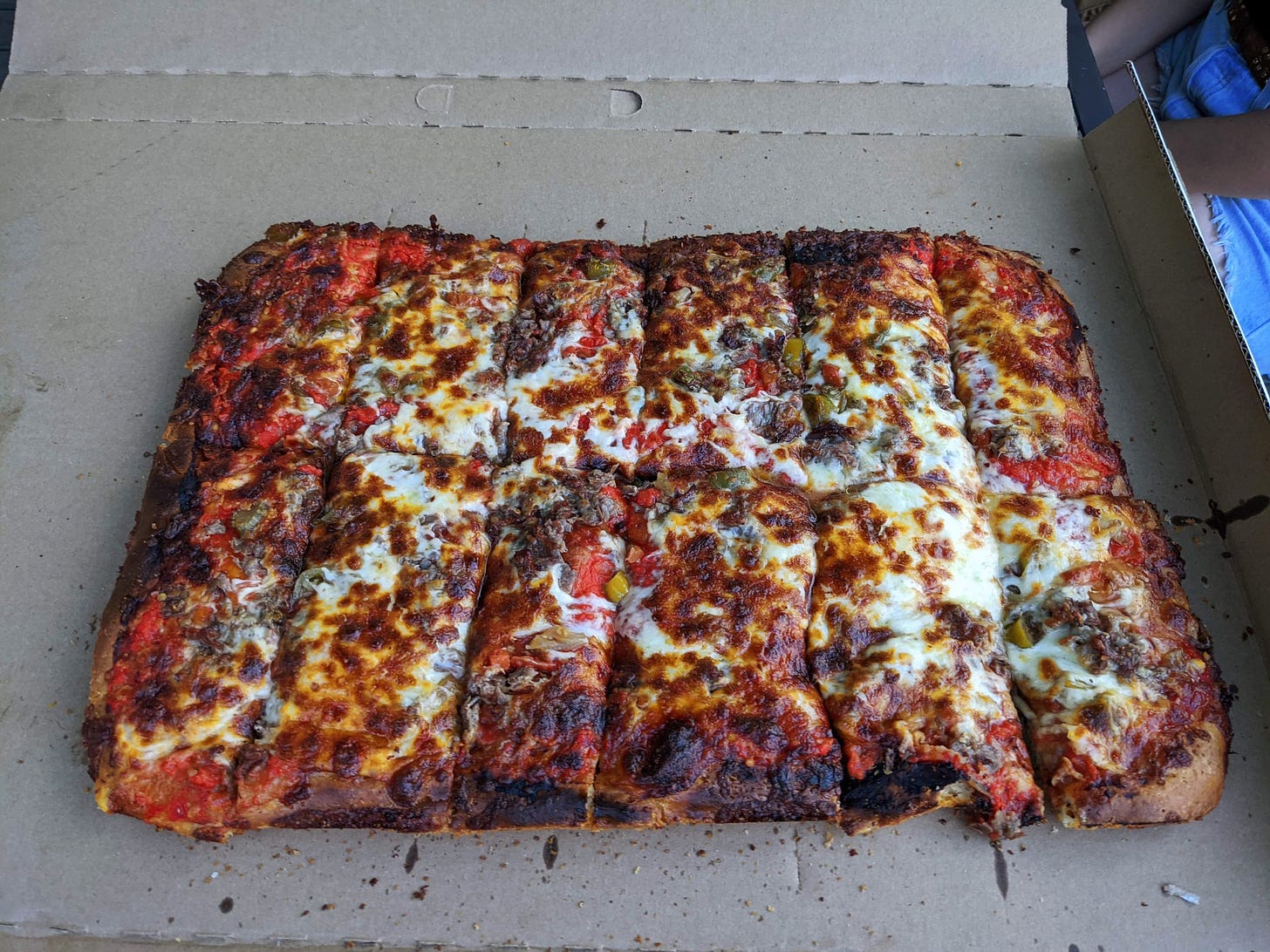
To assemble:
After a couple of hours, the dough should have visible signs of fermentation; it should be getting puffy, and some small bubbles should be visible. Once this happens, gently remove the plastic wrap, and with oiled hands, reach under the dough, gently coaxing it towards the edges and corners. It likely won’t fill the pan completely yet, and that’s okay. Place plastic over the dough again and revisit it in another hour or two. If the plastic wrap was sticking to the top of the dough when you removed it the first time, smear it with some additional oil. Similarly, if the dough is sticking to the bottom of the pan when you try to reach under it, add a little more oil underneath.
A few hours later, the dough should be pretty airy and relatively slack, and you should now be able to gently stretch it to fill the entire pan. Be extremely careful not to deflate the dough while stretching it. There will likely be some air pockets that are bigger than others, and it’s a good idea to use your oiled hands to gently redistribute this air so that the top of the dough is relatively flat. Cover again, and preheat your oven as hot as it goes.
Once the oven is preheated, and the dough is puffy and has filled the sheet pan, remove the sauce from the fridge, and with a ladle, cover the dough with a thin layer of the sauce, leaving about a half inch border of crust all the way around the pizza. Use about half of the sauce for this. This layer of sauce will keep the crust from drying out in the oven.
Place the pizza in the oven and bake until the crust has started to brown and the layer of sauce is not runny at all. Give the whole pan a couple of shakes and make sure that the center is not jiggling at all. This may take as few as ten minutes or as many as twenty, so just watch it. Err on the side of baking too much rather than not enough. Once you’re there, remove the pan from the oven.
Run a metal spatula around the edge of the pan and underneath the pizza to make sure that it’s not sticking. It probably won’t be, but if it is, it’s much easier to fix now than it will be once the pizza is fully topped. You can add a touch more oil underneath or around the edges if need be.
Top the pizza with the sliced mozzarella, the basil leaves, the rest of the sauce, and finally the pecorino, in that order. If you are using whole milk mozzarella (rather than part skim), you might also want to add a little salt here. Return the pizza to the oven and bake until hot all the way through. Again, shaking the pan a few times is the best way to check that the middle is done.
Remove the pizza from the oven and let it cool for about five minutes. You can cut it in the pan with kitchen scissors, but I like to lift the whole pizza out onto a cutting board and slice it there. Enjoy with wine, a Budweiser, twenty of your favorite people in the world, or a staggeringly intricate spumoni-inspired birthday cake.
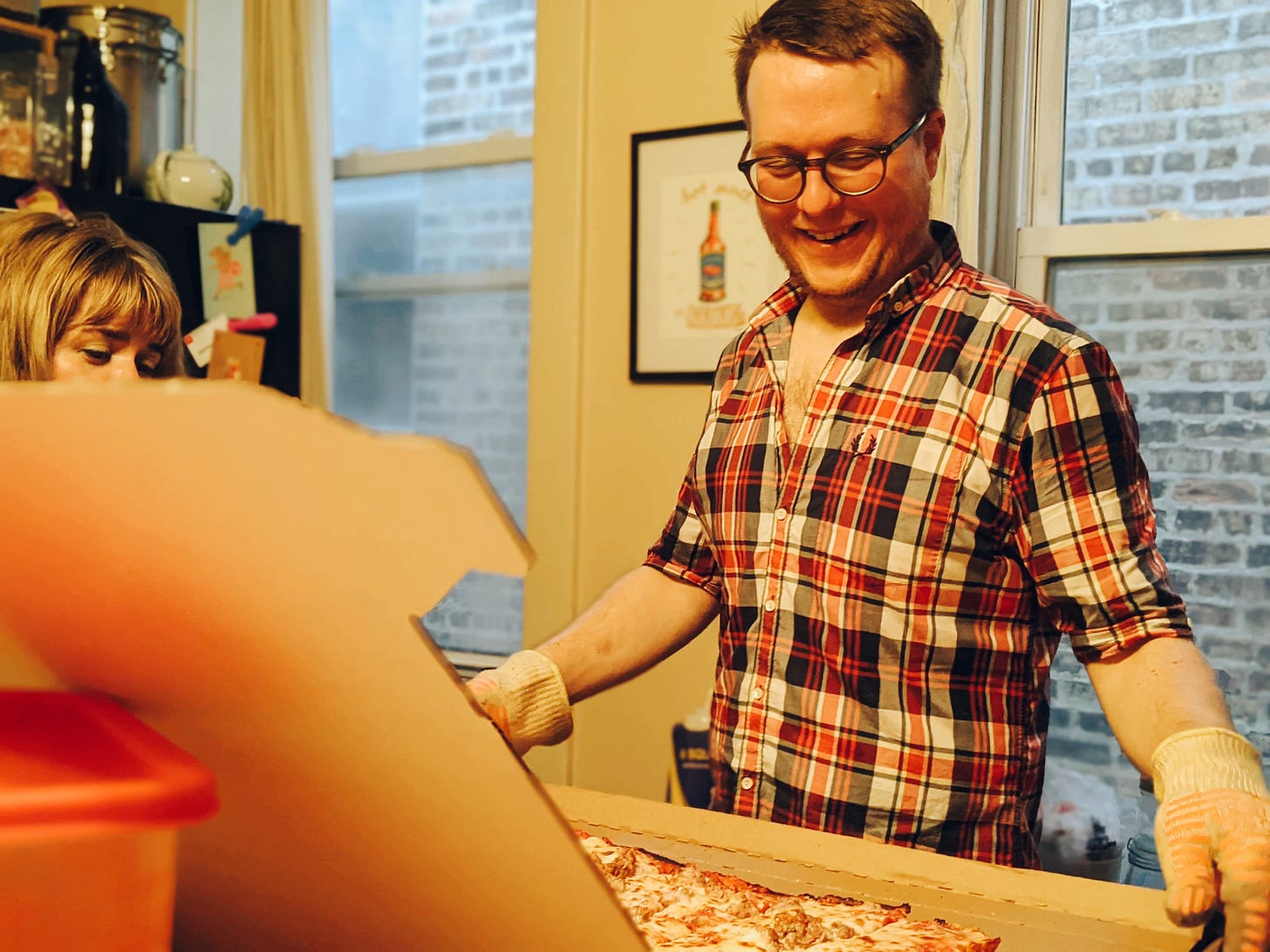
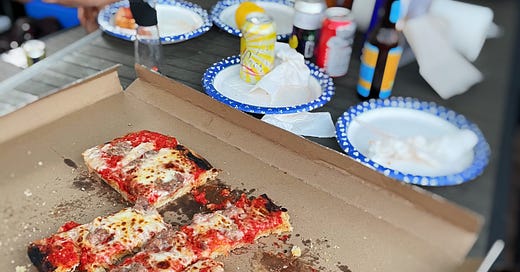



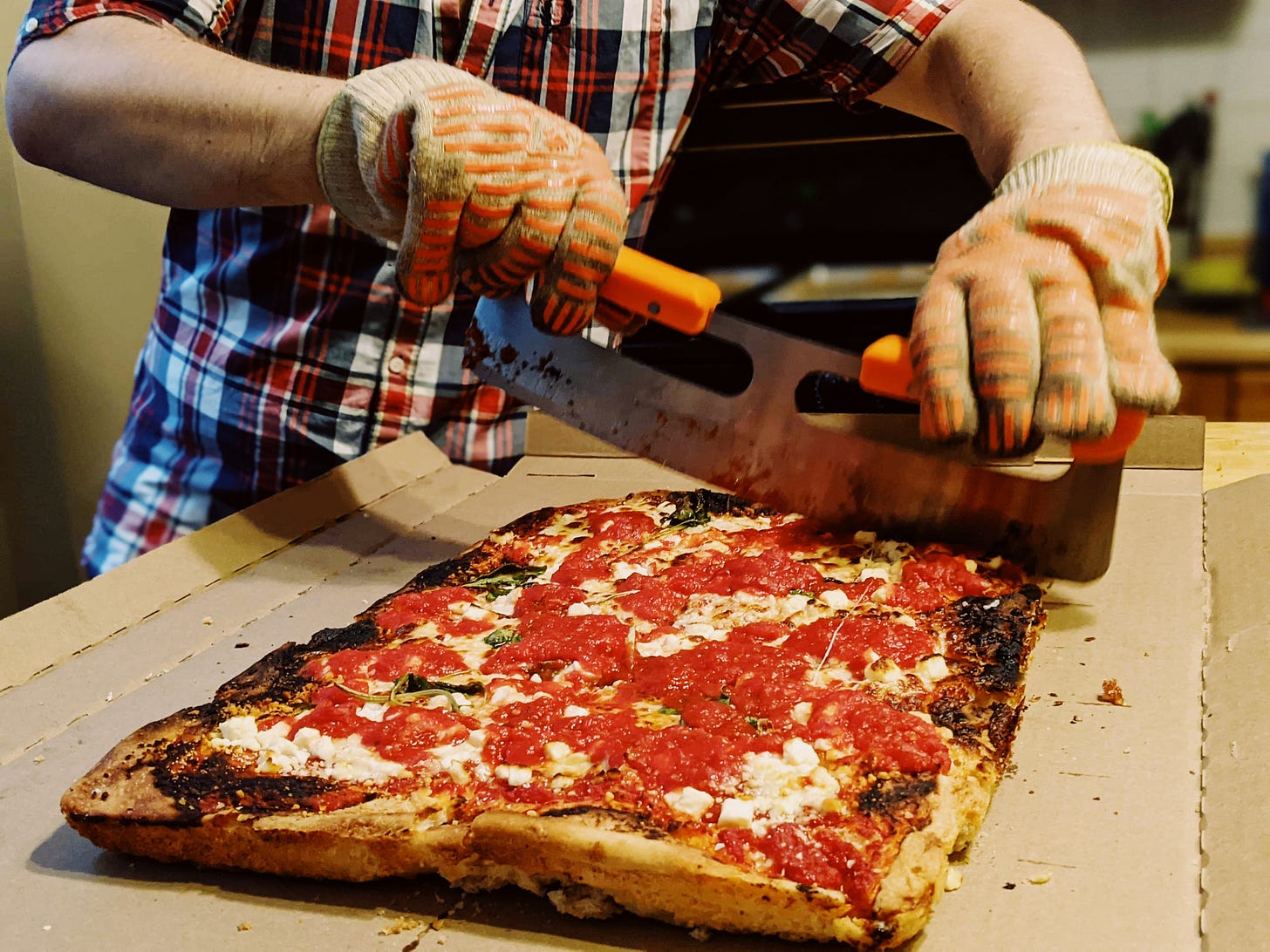

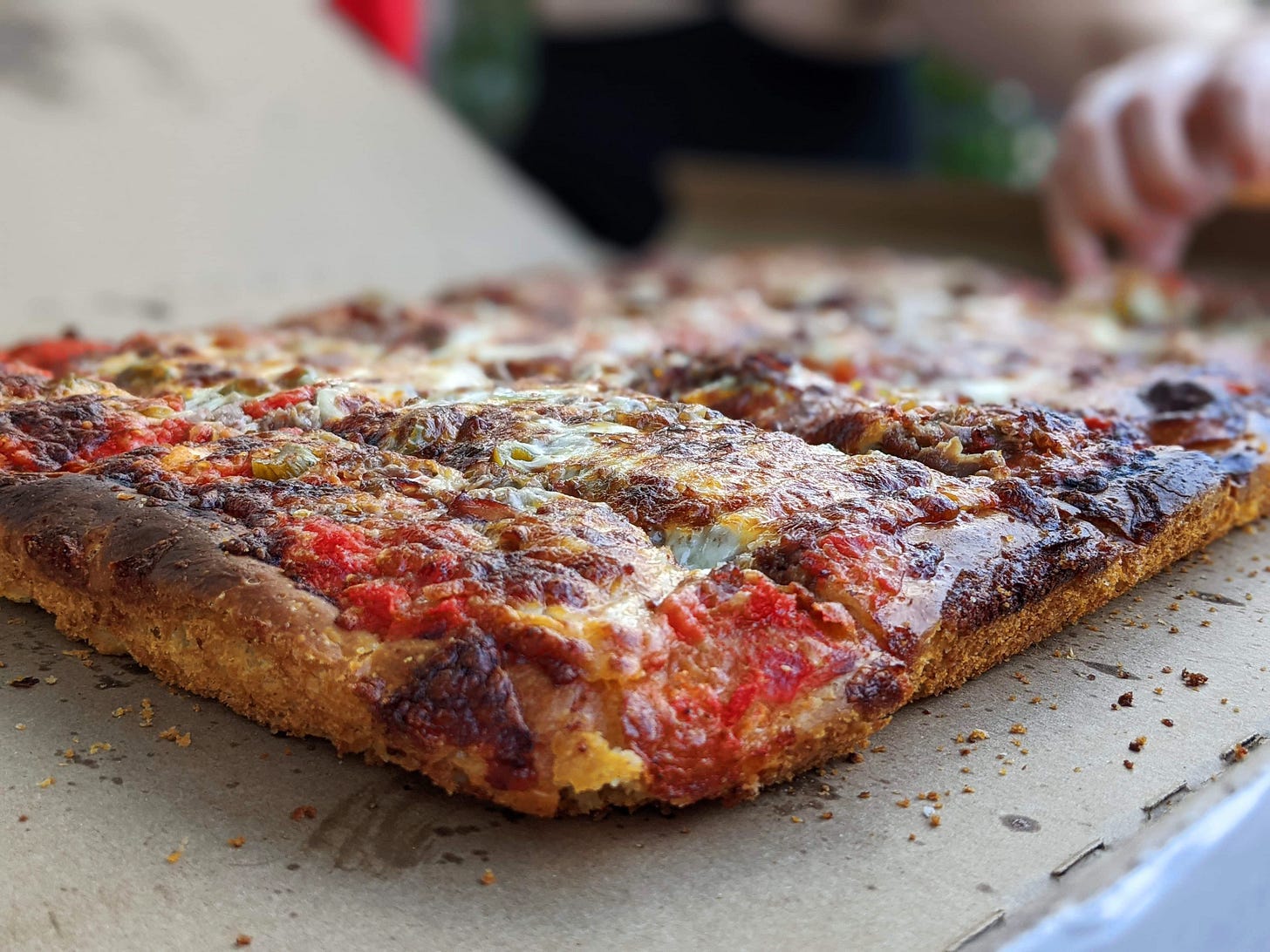
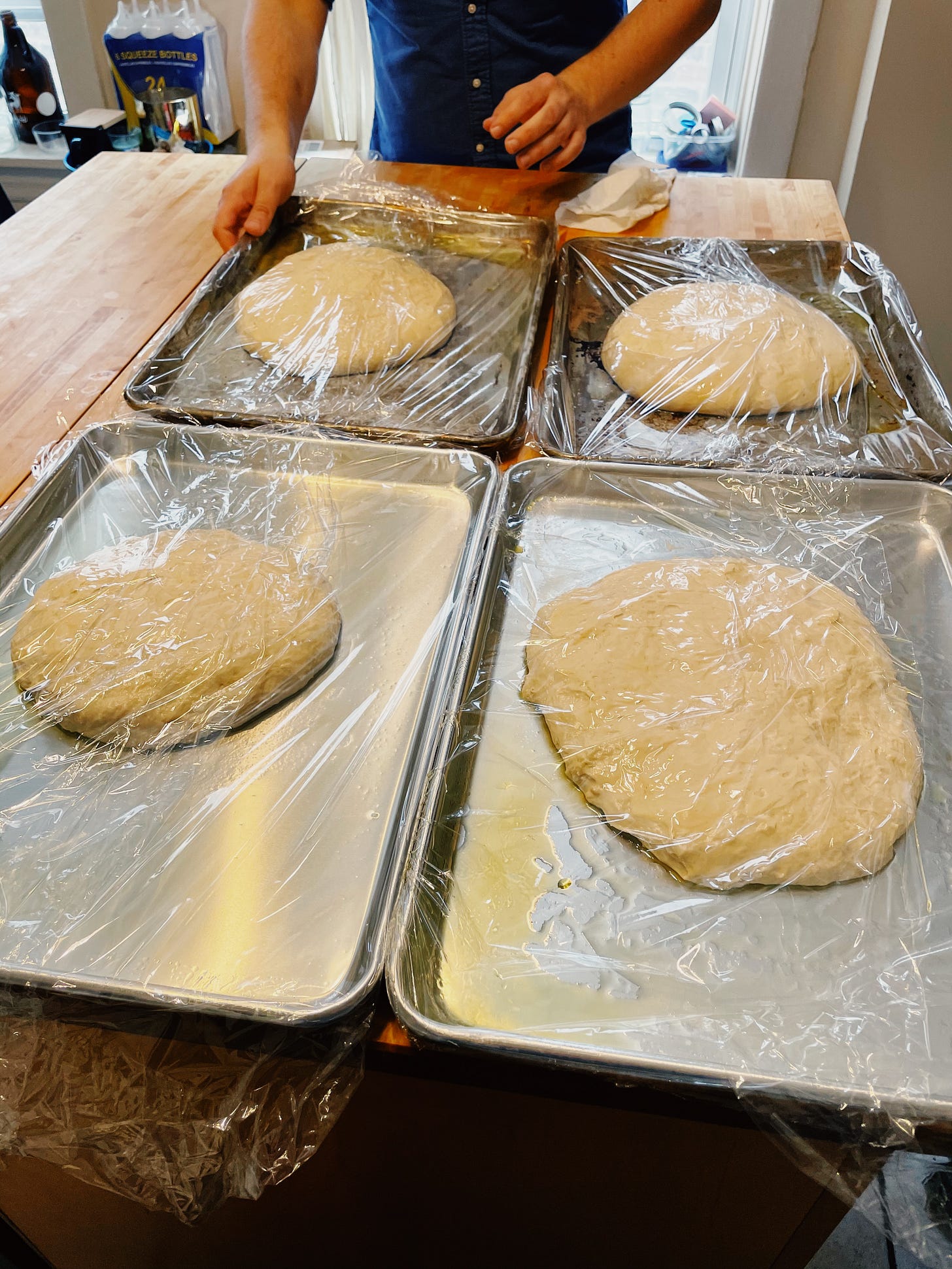

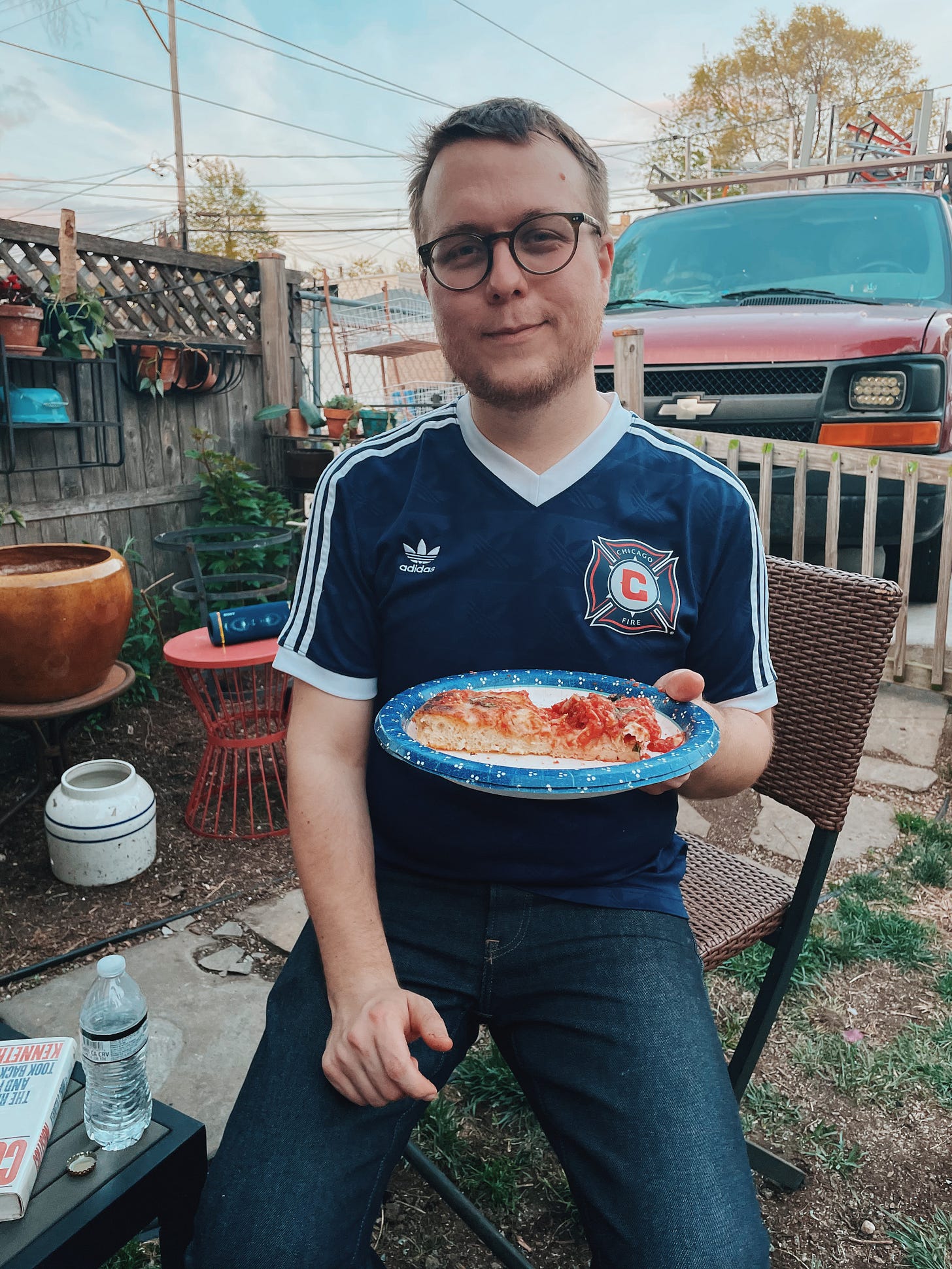

Wow it has never occurred to me that I could sweet talk my pizza place into selling me boxes, this changes.... everything
I’m hungry now! Looks and sounds delicious!